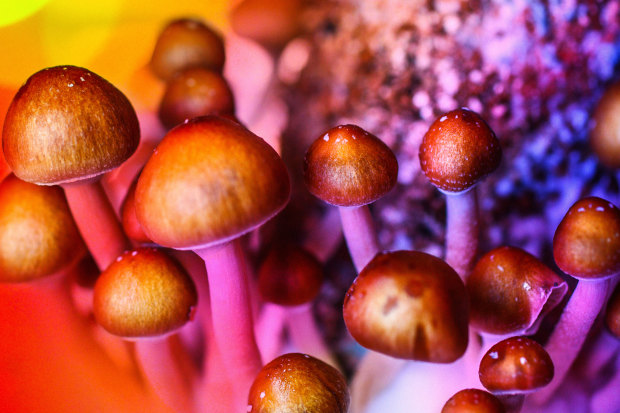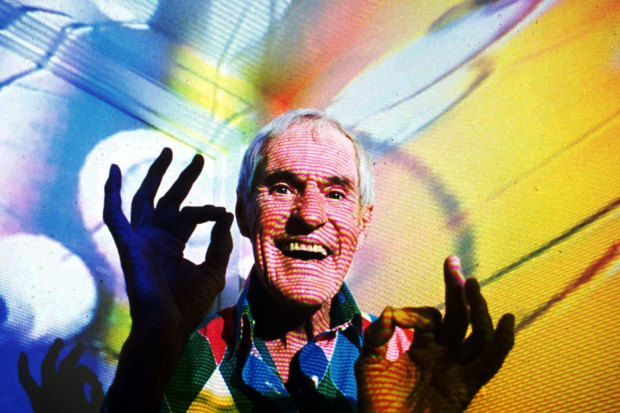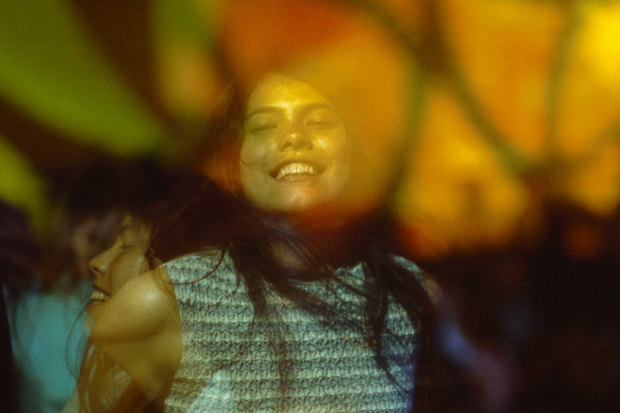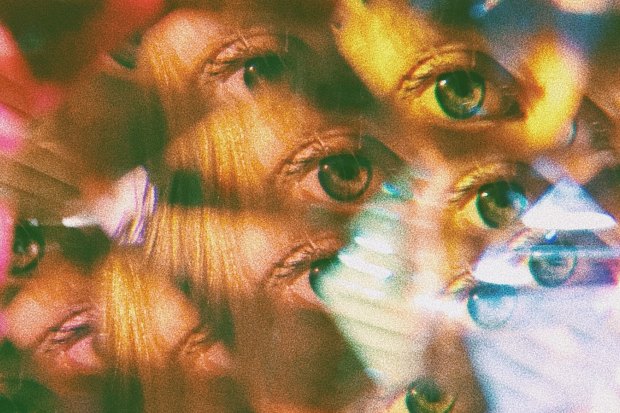Explainer
- Explainer
- Mental health
‘At one with the universe’: How can psychedelic drugs help treat suffering?
The active ingredient in magic mushrooms is one of the “trippy” drugs showing promise in treating depression, end-of-life terror and more. What might psychedelics reveal?
Most of us have an idea – or think we have an idea – of what psychedelics do to us. At their trippy best, drugs such as LSD and magic mushrooms can lead you to feel at one with the universe and awash with creativity. It was under the influence of LSD and peyote derived from cactuses that author Ken Kesey, for instance, wrote One Flew Over the Cuckoo’s Nest, tipped paint into a stream and dipped T-shirts in it (creating tie-dye), and discovered the world was “a hole filled with jewellery”.
There are, of course, bad trips, the extremes of which are perhaps best described by the late Boston crime boss James “Whitey” Bulger who, while incarcerated in an Atlanta penitentiary in 1957, was forcibly injected with LSD as part of the United States’ Central Intelligence Agency’s now infamous behaviour control experiments. “We experienced horrible periods of living nightmares and even blood coming out of the walls,” Bulger wrote.
In 1963, psychology professor Timothy Leary, who had started listing his profession on academic forms as “ANGEL”, was booted out of Harvard University for his research into psychedelics, notably LSD and psilocybin, the active ingredient in magic mushrooms. He gave the psilocybin to undergraduate students when the university had agreed he could only give it to graduate students in his studies – as a tool in psychotherapy and “mind expansion”. While psychedelics were a hallmark of the counter-cultural hippie movement, by 1970 they had been criminalised, thanks to US president Richard Nixon’s war on drugs.
In Australia, psychedelics were used by doctors to treat various psychological conditions – none of it systematically documented – but they began to be criminalised from 1970 onwards and remain, mostly, illegal. So, how is it that we’re now in the middle of a psychedelic renaissance?
In March 2021, the Australian federal government announced it would provide $15 million for clinical trials to determine whether psilocybin and MDMA could help treat debilitating mental illness. In July, a new privately funded research centre was launched in Melbourne to develop psychedelic medicines. Meanwhile, leading research is underway in a Melbourne hospital into the use of psilocybin to treat end-of-life anxiety and depression in terminally ill patients.
These trials follow an enormous amount of psychedelics research over the past 20 years, in the US and Europe, which has led to promising findings about the role they might play in treating conditions ranging from severe depression and post-traumatic stress disorder (PTSD) to addiction, Alzheimer’s disease and anorexia nervosa. In fact, in 2021 there were about 100 psychedelics trials worldwide, at prestigious institutions such as Johns Hopkins University in the US, which launched a Centre for Psychedelic and Consciousness Research in 2020, and Imperial College London, which opened its Imperial Centre for Psychedelic Research in 2019.
What are these studies hoping to find? Could these mind-altering drugs be the long-sought answer to alleviating suffering caused by mental illnesses where other treatments have failed? Do they reveal the secrets of the universe? And what are the risks?

Psilocybin is the “active” ingredient in “magic” mushrooms. Credit: Getty Images
What are psychedelic drugs and what can they do to us?
Psychedelics refer to a broad range of pharmacological compounds that include LSD (d-lysergic acid diethylamide), psilocybin, ayahuasca (pronounced aya-washka, a South American psychoactive brew traditionally used in shamanistic ceremonies), MDMA (known as ecstasy) and ketamine (often called Special K). Broadly speaking, they work by simulating, suppressing or modulating the activity of the various neurotransmitters in the brain – the body’s so-called chemical messengers – which carry messages between nerve cells, keep our brains functioning and affect various psychological functions such as fear, pleasure and joy. This leads to a temporary chemical imbalance that can result in, among other effects, euphoria and hallucinations.
The term psychedelic – from the Ancient Greek words psyche (soul) and deloun (to make visible, to reveal) – was coined in the 1950s by British psychiatrist Humphry Osmond, who was part of a small group of psychiatrists researching the therapeutic potential of LSD in treating alcoholism and other mental disorders.
‘It’s like 10 blind people feeling an elephant from different angles – none of them has the full picture.’
But even today, researchers don’t know exactly how psychedelics do what they do to our brains. “It’s like 10 blind people feeling an elephant from different angles – none of them has the full picture,” says University of NSW’s Dr Colleen Loo, a professorial fellow at the Black Dog Institute who is the foremost Australian researcher of the use of ketamine. Ketamine is a powerful animal and human anaesthetic that is legal in Australia, with limitations, and is being used to tackle depression that’s resistant to other treatments. One thing researchers know is that ketamine promotes the growth of nerve cells that have shrunk in the brains of people with depression.
The fact that the broader picture is far from complete isn’t a red flag in itself, given we commonly take medicines even though doctors don’t know exactly how they work. “In a sense, knowing how it [a drug] works becomes probably less important if we know that something works, and if we know that treatment’s safety profile,” says Dr Vinay Lakra, president elect of the Royal Australian and New Zealand College of Psychiatrists.
For one thing, psychedelics have been shown to increase cognitive flexibility. This doesn’t so much refer to the more spectacular effects of psychedelics we often hear about, but rather the way that psychedelics disrupt our “default mode network” – the part of the brain that is active when we are at rest, where we think about the future and the past and incorporate things that have happened to us. It is central to defining who we are.
In many people, the stories they tell themselves are embedded in rigid and destructive patterns of thought: people with depression or anxiety often tell themselves they’re worthless and unlovable. Those who have experienced trauma often feel a sense of survivor’s guilt.
Psychedelics, in conjunction with psychotherapy, temporarily short-circuit these ruminative, and frequently negative, mental loops. In doing so, they help provide new perspectives on old problems. Michael Pollan, a Berkeley journalism professor who chronicled his encounters with psychedelics in a 2018 book How to Change Your Mind, spoke to one man who had quit smoking after a psychedelic trip “because I found it irrelevant”.
‘People often see patterns and geometry, or weird sort of things ... they might feel like they’re warping, melting or dissolving.’
Many trippers also describe a temporary breakdown of identity, erasing the distinction between self and non-self, which also seems to have benefits. As people involved in a psilocybin smoking cessation trial variously recounted to Pollan, “I died three times. I sprouted wings. I flew through European histories. I beheld all these wonders. I saw my body on a funeral pyre on the Ganges. And I realised, the universe is so amazing and there’s so much to do in it that killing myself seemed really stupid.”
Other people in clinical psilocybin trials report radically heightened senses, says Dr Margaret Ross, chief principal investigator of a psilocybin-assisted psychotherapy study at St Vincent’s Hospital in Melbourne. “Music can sound amazing, or people can see music,” she says.
“Their visual field is often impacted; they see all the colours, people often see patterns and geometry, or weird sort of things. They can also experience their body very differently, they might feel like they’re warping, melting or dissolving.”
“[They’re] kind of at one with the universe, if you like,” says Dr Paul Liknaitzky, a research fellow at Monash University who is the lead investigator on four psychedelics trials, “and exist beyond space and time and thought, and these are often called mystical experiences. It’s a little like what astronauts report from looking at the Earth from outer space – this enormous perspective on life that allows people to no longer fear death, or no longer fear anything, because they’ve got a different perspective on things.”

Timothy Leary, the former LSD experimenter, in his home in California in 1992 with video images projected over him. Leary died of cancer in 1996.Credit: AP
This is why, says Liknaitzky, psychotherapy-assisted psychedelics are being trialled to treat so many different problems, from end-of-life anxiety and terror to nicotine and cocaine addiction, to PTSD. The drugs address “more fundamental aspects of psychological distress than just the symptoms” – although it’s no reductive pill-popping exercise.
The clinical trials almost always include multiple psychotherapy sessions to help address fears and personal history, and to help the patient make sense of their psychedelic experiences. No current trials or experiments simply use the drugs by themselves; in many, the therapy incorporates lifestyle changes such as better eating and exercise.
One woman who participated in a psilocybin trial to combat nicotine addiction at Johns Hopkins – but who ended up confronting long-held grief about the breakdown of her marriage and a miscarriage – told Dr Albert Garcia-Romeu, “It really helped me move forward.”
“It was almost like a letting go of some grief that had been in there, that she may not have wanted to deal with, or acknowledge,” says Garcia-Romeu, who is involved with numerous psychedelics trials.
Another woman with terminal colon cancer reported that taking psilocybin enabled her to enjoy her final months of life when she was otherwise paralysed from making even the most mundane plans, so mired was she in fear. “I felt this lump of emotions welling up … almost like an entity,” she told researchers in the Harbor-UCLA Medical Centre trial.
“I started to cry. Everything was concentrated and came welling up and then it started to dissipate and I started to look at it differently. I began to realise that all of this negative fear and guilt was such a hindrance … to making the most of and enjoying the healthy time that I’m having.”
The same, it’s been reported, can go for LSD. The New York Times reported on a trial using LSD-assisted talk therapy for people with end-of-life anxiety: “One 67-year-old man said he met his long-dead, estranged father somewhere out in the cosmos, nodding in approval.”
It’s not all sunshine, rainbow-enveloped self-acceptance and tripping across the cosmos, though. The work can be confronting, as with much therapy. One woman who had been sexually assaulted by her father as a child, and who was suffering from PTSD as a result, ended up “transferring” her anger and sadness onto a male psychotherapist who was guiding her through an MDMA trial in the US. “She was actually quite distressed the next day when she realised what had happened [during the trip],” says Dr Stephen Bright, senior lecturer of addiction at Edith Cowan University, who witnessed the session. But, despite her embarrassment at lashing out, the treatment lessened her PTSD symptoms. (PTSD symptoms include anguish-inducing flashbacks and hypervigilance.)

Credit: Getty Images
Why the interest in psychedelics now?
“All of a sudden, it hasn’t got that kind of ‘counter-culture’ tag,” says Ross. She points to testimonials from high-profile, respected journalists and writers such as Pollan, who was in his 60s when he wrote his book about trying psychedelics. “I felt my sense of self scatter to the wind,” Pollan told National Public Radio, “almost as if a pile of Post-Its had been released to the wind – but I felt fine with it. Then I looked out and saw myself spread over the landscape like a coat of paint or butter.” Pollan says the drugs act upon “the self that talks to the self”.
The year before, author Ayelet Waldman published a memoir about how microdosing on LSD saved her marriage, by, among other things, easing her depression and bipolar disorder. “It changes the profile of who would use something like this,” says Ross, whose study focuses on whether psilocybin alleviates anxiety and depression in terminally ill patients.
Brain sciences and scans that reveal brain activity have also been trending over the past decade, lending legitimacy to psychedelics studies, says Garcia-Romeu. “If you can measure something in the brain then you can point to a mechanism, and so understanding the biological and brain-based mechanism is an important part of validating this work from a kind of more hard science perspective, if you will,” he says. (Some researchers now refer to their trials as “anti-Leary” as Leary’s studies were largely anecdotal.)
This modern research dovetails with a growing dissatisfaction within the scientific and medical communities with current treatments for depression and anxiety.
Although antidepressants work for many people, they don’t for large portions of the population. And they “really don’t offer much” for people with terminal illnesses experiencing end-of-life anxiety and depression, says psychiatrist Justin Dwyer, who is leading the St Vincent’s Hospital psilocybin trial, along with Ross.
“For giving people this sense of reconnection, of oneness with family, of meaning, of purpose, of feeling as though there’s much more to them than their illness, antidepressants do nothing.”
For one thing, he says, antidepressants often take weeks to work, and frequently cause nausea, which might interact with pain medication, and have a sedating effect when people are most longing for connection.

Credit: Getty Images
What have psychedelics studies found?
A groundbreaking study from Johns Hopkins in 2016 found that, of 51 cancer patients suffering psychosocial distress, 80 per cent who received psilocybin (with psychological support) had significant reductions in depressed mood and anxiety. Data suggests the treatment lowers anguish for as long as six to nine months afterwards, says Garcia-Romeu.
A 2020 study from Johns Hopkins showed that psilocybin, taken by people with major depressive disorder, showed effects four times greater than standard antidepressants. And another Johns Hopkins psilocybin study, from 2014, reported that of 15 participants, 80 per cent abstained from smoking over six months. A year later, 67 per cent of participants still abstained. (This compares to a 35 per cent success rate for patients taking Varenicline, a prescription medication widely considered to be the most effective smoking-cessation drug.)
As for treating PTSD, a study from the non-profit Multidisciplinary Association for Psychedelic Studies (MAPS) in California found that, of 107 participants with chronic, treatment-resistant PTSD (who suffered, on average, for nearly 18 years), 61 per cent no longer qualified for PTSD after three sessions of MDMA-assisted therapy. At the 12-month follow-up, 68 per cent no longer had PTSD.
And what of LSD? The 12 people who participated in one Swiss trial of LSD-complimented talk therapy as they neared the end of their lives reported positive results. “Their anxiety went down and stayed down,” psychiatrist Dr Peter Gasser has said.
Participants ... experienced an immediate boost in mood and a feeling of connection ... as well as significant drops in depression and stress – but no drop in anxiety. They also reported a significant increase in neuroticism.
And that microdosing that Ayelet Waldman found so life-changing? There are few studies of microdosing but one of the first, from Macquarie University in NSW in 2019, found mixed results. Ninety-eight study participants who took “super low doses” of various psychedelics over six weeks – including psilocybin, LSD and mescaline – experienced an immediate boost in mood and a feeling of connection with their surroundings as well as significant drops in depression and stress but no drop in anxiety. They also reported a significant increase in neuroticism – a tendency to feel sad, angry, anxious or vulnerable – although a subsequent study by Macquarie found its microdosers experienced a decrease in neuroticism.
Almost none of these clinical trials has yet moved to phase three, which typically lasts between one and three years and confirms safety and effectiveness on large populations, comparing the drugs to standard therapies. MAPS in California published the results of its phase-three trial of MDMA-assisted psychotherapy to treat severe PTSD in 2021. Ninety people participated in the trial. Two months after treatment, 67 per cent in the MDMA group no longer qualified for a diagnosis of PTSD compared with 32 per cent in the placebo group.
Professor Michael Farrell, director of the National Drug and Alcohol Research Centre at the University of NSW, is glad that research is being done on psychedelics but cites the lack of large-scale trials so far as one reason to be cautious. Small trials make it difficult to prove cause and effect, for example. “When people say that there’s now very strong evidence [for psychedelics’ benefits], I wouldn’t agree with that.”
Wayne Hall, an emeritus professor at the National Centre for Youth Substance Use Research at the University of Queensland, agrees, saying that any new drug can have a “placebo effect” among participants and practitioners who are “really convinced of the value of what they’re giving”. But he says, “It is pretty promising that they’ve [researchers] managed to get clinically significant effects in the trials that they have with numbers as small as they have – that’s encouraging.” Larger trials will give a clearer picture of who will likely benefit from psychedelics, and under what circumstances.

Credit: Getty Images
What are the risks of taking these drugs?
Psychedelics might not generally, as many experts put it, “follow the cycle of abuse” – they don’t typically lead to addiction, cravings or withdrawal. Apart from anything, unlike addictive drugs such as heroin, which triggers euphoria (at least at first) or benzodiazepines, which melt anxiety, psychedelics have unpredictable and often frightening effects, says Bright, which means people rarely take them as often as one would need to in order to become addicted.
That said, the risks are myriad and taking psychedelics can have tragic results. In rare instances, some psychedelics can evoke a lasting psychotic reaction, more often in people with a family history of psychosis. (Participants in clinical trials, who must be above the age of 18, are screened for a family history of psychosis, schizophrenia and other conditions including bipolar disorder and complex trauma, which could lead to damaging outcomes.)
MDMA, which is a stimulant – the MA is for methamphetamine – elevates heart rate, blood pressure and body temperature. “So, if you’re in a panic state, that would increase your panic state,” says Dr Monica Barrett, a social scientist at the University of NSW and the lead Australian research for the Global Drug Survey, a London-based research company that monitors drug use. In rare cases, MDMA can lead to serotonin syndrome, which causes overheating and can kill, as has been seen at music festivals. And, of course, when people take psychedelics in a non-clinical setting, the hallucinations can lead them to take potentially fatal risks such as walking into traffic or jumping from a high place in the belief that they can fly.
‘Their PTSD could actually become worse because they’re being retraumatised rather than reprocessing their trauma.’
Then there’s the reality that many psychedelics being offered by a burgeoning number of sometimes-untrained underground psychotherapy practitioners – outside clinical trials – are not using pharmaceutical-grade drugs. “That’s Russian roulette,” says Bright. “Their PTSD could actually become worse because they’re being retraumatised rather than reprocessing their trauma. [And] it creates a lot of suggestibility, so you could brainwash people.”
Bright remembers one woman who presented at a Victorian clinic he worked at who had been sexually assaulted two years prior to showing up but had no PTSD before she used psilocybin one day at home with her partner. “She freaked out, her partner called a paramedic, she was taken to the hospital, the psychedelics were reversed with an anti-psychotic – and she developed PTSD and a drinking problem.”
Recreational users who take high doses of ketamine over long periods report a condition called “ketamine bladder”: the organ becomes so inflamed the lining dies off. Sometimes, the entire bladder needs to be removed. Ketamine also features a risk even in a clinical setting – of relapse. (Dr Loo’s trials have not featured a psychotherapy component.) “He said he’d had this amazing experience,” she says, recalling a male participant in the first Australian clinical trial of ketamine for depression. Within four hours of taking the drug, he started changing before her eyes, as many who take ketamine do: faces brighter, more reactive. “They’ve got a spring in their step,” she says. But by the end of the week, the effects had worn off. The anti-depressant qualities of ketamine often fade after a few days, and treatment, due to governmental restrictions, is allowed for only two months at a time. “He said something to me I’ve never forgotten, that the devastation of the relapse was bigger than the elation of getting well,” says Loo.
For other people, she says, ketamine provides welcome, temporary relief as a treatment of last resort when all else, including antidepressants and psychiatric therapy, have failed. “It’s not an easy treatment to manage,” she says, but she’s been “completely astounded” by its impact on some patients. “It’s truly amazing ... You could see the same person yesterday, and today [after treatment] a completely different person.” (She wants to next investigate the use of ketamine, this time combined with psychotherapy, to manage treatment-resistant anxiety.)

Credit: Getty Images
What’s next for psychedelics in Australia?
In July, a $40-million global institute was launched to develop new psychedelic medicines and psycotherapeutic treatment models to go with them. The Psychae Institute, in Melbourne, is funded by a North American biotechnology company and aims to connect leading researchers from across the globe, including Swinburne University, the University of Melbourne and the Florey Institute of Neuroscience and Mental Health. The company, which has been vetted by the universities and Agriculture Victoria, wants to remain private as part of its strategy to secure private investment.
Australian experts say that, after years of trailing in the psychedelics research race, they are swiftly catching up. In 2021, six clinical trials of MDMA or psilocybin were planned or underway, including one at St Vincent’s Hospital in Melbourne, which is testing psilocybin for treatment-resistant depression and end-of-life anxiety and depression. This study would expand on previous research, as it’s being conducted with terminally ill patients who have a number of diseases and conditions, whereas the 2016 Johns Hopkins trial, its most important predecessor, treated only patients with cancer. If a trial eventually leads to treatment approval, the approval is only for the illnesses that it’s been trialled on.
Ross, who has long worked in palliative care as a clinical psychologist, hopes the St Vincent’s Melbourne study confirms the Johns Hopkins findings because “people are not coming along to us saying, ‘I’m depressed and anxious [at end of life]’. What they’re doing is saying, ‘I’m terrified. I’ve lost all sense of meaning and purpose in my life. I feel completely unmoored from everything that gives me a feeling of identity’. They may have limited time left and they’re spending it anguished and pulling away from people.”
Early in 2021, Australia’s drug regulator, the Therapeutic Goods Administration (TGA), rejected a push by the not-for-profit organisation Mind Medicine Australia to allow psychiatrists to prescribe MDMA and psilocybin because of lack of evidence as to its efficacy. It was an interim decision, and the TGA has since sought independent review of the evidence. Many local researchers were relieved. “There are a lot of evangelistic claims being made but this is no silver bullet,” says Bright about psychedelics, adding that the hype could encourage people to embark on unsafe experiments in non-clinical settings. “Desperate people will do desperate things – they will go, ‘How will I find this?’ ”
Parts of the US are embracing psychedelics. In 2019, the city of Denver decriminalised magic mushrooms ...
However, Bright adds that, historically, the TGA has followed rulings by the US Food and Drug Administration and, increasingly, the FDA is supporting psychedelics. In 2017, it granted “breakthrough therapy status” to MDMA-assisted psychotherapy, meaning it will develop and review it faster than other candidate therapies for PTSD. Bright predicts the FDA will approve MDMA-assisted psychotherapy for PTSD in the US by 2024, with Australia following suit after that. Garcia-Romeu predicts that, in the US, laws allowing psilocybin-psychotherapy assisted treatment for depression “will probably be five years [away], maybe”.
In the meantime, parts of the US are embracing psychedelics. In 2019, the city of Denver decriminalised magic mushrooms, or psilocybin, after a referendum. In 2020, Oregon became the first US state to vote to legalise psilocybin for therapeutic use.
Garcia-Romeu is wary about people believing that psychedelics might offer a “magic pill that will solve all their problems.
“I always say, ‘This is not going to pay your bills, it’s not going to wash your dishes, or fix your relationship with your estranged family members.’
“You don’t just take a pill, and all of a sudden you’re in fantastic shape.”
correction
The company funding the Psychae Institute was originally described as a US investment company. It is a North American biotechnology company. The article, along with an associated news report, has been updated to reflect that the company has been vetted by relevant universities and Agriculture Victoria, and wants to remain private as part of its strategy to secure private investment. And participants in a Macquarie University study of microdosing took various psychedelics, not just psilocybin, as originally reported.
Let us explain
If you'd like some expert background on an issue or a news event, drop us a line at explainers@smh.com.au or explainers@theage.com.au. Read more explainers here.